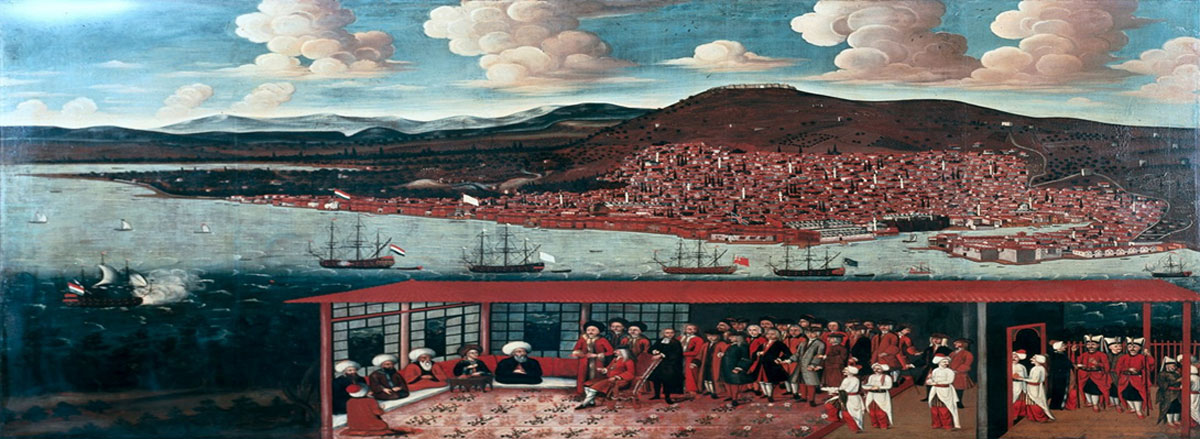 |
View of Smyrna around 1900.
 |
A painting of Smyrna bay and Dutch merchants negotiating with the local kadı done possibly by Cornelis de Bruijn (1652 – 1726/7), a Dutch artist and traveler who briefly stayed amongst Dutch merchants of Smyrna c.1683. St Peter’s Castle is the black building at 2 o’clock above the vessel with the blue flag. From this painting it is evident that the creek in front of the castle had been filled in, therefore the reason Saman İskelesi etc. are now so far inland.
This picture also offers a challenge to budding or actual archaeologists to investigate the location of the city walls shown on the right hand side, and perhaps the elusive St Polycarp’s tomb (the building below the castle, flanked with 2 little white towers ?).
The locations of European factories are marked by the flags of Holland, France (the white Fleur de Lys?), Britain (Union flag, above the merchant navy ‘Red Duster’), then a red flag which I identify as Venice, but is there a Lion? The vessel with the blue flag: 1st from the right would be a blue fleur-de-lys used by the French navy, or the French Merchant Flag?
Finally, notice the 21 gun salute of the arrival Dutch ship; bottom of the picture left - analysis courtesy of George Galdies.
This picture also offers a challenge to budding or actual archaeologists to investigate the location of the city walls shown on the right hand side, and perhaps the elusive St Polycarp’s tomb (the building below the castle, flanked with 2 little white towers ?).
The locations of European factories are marked by the flags of Holland, France (the white Fleur de Lys?), Britain (Union flag, above the merchant navy ‘Red Duster’), then a red flag which I identify as Venice, but is there a Lion? The vessel with the blue flag: 1st from the right would be a blue fleur-de-lys used by the French navy, or the French Merchant Flag?
Finally, notice the 21 gun salute of the arrival Dutch ship; bottom of the picture left - analysis courtesy of George Galdies.
 |
The inner harbour is also visible in this engraving of published by A. M. Myller, Peregrinus in Jerusalem (Fremdling zu Jerusalem), 1735, engraved by J. Hiller. The engraver has noted the word TELONIUM in the sea area below the port. This word comes from the Latin, meaning an excise duty paid by merchants, or a toll. From a book by A. M. Myller recounting his travels from 1725 to 1727.
 |
A rather fanciful painting by the French artist Jean Leon Gerome (1824-1904) entitled ‘The Janissaries Patrol Smyrna’.